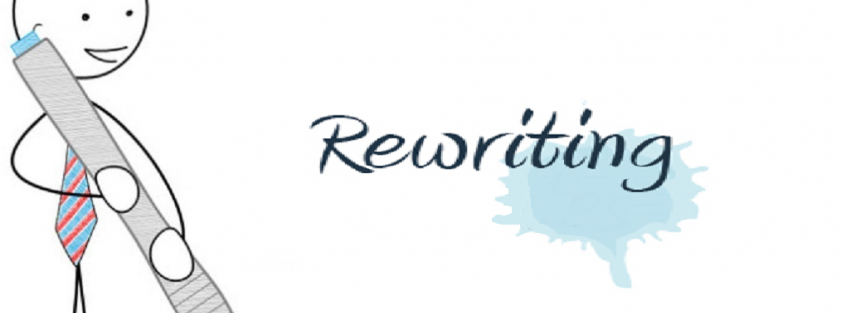Critical Tips on How to Effectively Rewrite Paragraph
“Rewrite using your own words!” is perhaps a comment that your professor keeps repeating in your paper, and however much you try, you have not been able to get it right. Rewriting a text is simple yet a daunting task if you do not know how to approach it. While rewriting is a subject that is often ignored, and more often than not, poorly covered by English teachers due to its seemingly lower usage in conversations, the latter becomes the foundation of essays and research papers in general as one moves up the academic ladder. Rewrite is a word formed by adding a prefix “re” to the verb write. The simplest meaning for rewriting is basically writing again. But wait a minute, it does not make any sense to write a piece again without altering a word or changing the sentence structure, does it? Therefore, the concept of rewriting is characterized by these aspects; writing a given sentence, paragraph, or piece of writing again, while altering some words and changing the sentence structure, and still maintaining the original meaning of the author of the text. Below are some of the critical points to note when you are asked to rewrite a paragraph.
Read and Understand the Relevant Piece of Writing.
Everything in the academic world revolves around reading and understanding. You cannot decipher the meaning of a written text unless you understand it. The essence of reading and understanding the given piece is to make sure that you do not misinterpret the intended meaning of the writing. Without understanding the meaning, the rewritten paragraph is as well meaningless! The meaning of the written piece may be more than the eyes meet. In some cases, it may be necessary to check on the punctuation of the sentence so as to grasp the intended meaning. For instance, a sentence that ends with a period is quite different from one that ends with a question mark; the same case applies to exclamation marks.
Consider this example
Original text:
- The event is for couples; single ladies keep off!
- The event is for couples; single ladies keep off.
While the former is more of a command and a warning, directing the targeted audience to keep off, the latter is used to indicate a declaration. As such, while the first sentence is an exclamatory sentence, the second one is not. Understanding the sentence structure is, therefore, a critical aspect of rewriting.
Correctly rewritten text:
Were we to rewrite the two sentences, we would have something like:
- Unmarried ladies should not attend the event, as it is made for couples.
- Unmarried ladies are advised not to attend the event as it is made for couples.
While the two rewritten sentences are seemingly the same, in the first sentence, the phrase “should not” has been used to show that it is an order that must be complied with. The second sentence uses the word “not to,” which is indicates an advisory and not a command.
From the above examples, it is clear that the first step in rewriting begins by understanding the meaning that the writer intends to pass, not only by focusing on the content and context but also the punctuation of the sentences.
Understand the Content and Context of the Original Text
For you to effectively rewrite a piece, you must as well understand the content and context of the piece in question. With respect to content, it is critical to understand the overarching theme or meaning of the writer in that particular paragraph. The content aspect of rewriting focuses on the specific experiences and information that the writer wishes to pass to the targeted readership. By focussing on the content, ask yourself, “What information does the writer want to pass to the reader?” Failure to conceptualize the content of the academic piece may result in misunderstanding and subsequent misrepresentation of facts and critical information derived from the original piece. To make the best out of the writing, try to analyze the content by focusing on the main ideas and concepts that the text is based on.
Consider this example
Original text:
Poor research strategy results in unreliable research conclusion that cannot be justified and generalized to the population under investigation.
In the above statement, the underlined words are keywords or concepts that the writer wishes to pass to the targeted audience. As such, when rewriting, you must ensure that your rewritten sentence takes into consideration the overall message defined by these keywords/concepts.
Correctly rewritten text:
Unrealistic research findings that do not reflect the true characteristics of the population being studied are likely to be obtained if the right research approach is not followed.
From the above, it is clear that the content of the written and the rewritten sentences bears the same meaning.
Context is a crucial element too. The context is basically the setting for an idea, statement, or event that can be fully assessed and conceptualized. As such, context defines the background or situation surrounding the information in question. For instance, in healthcare and related medical disciplines, clients are usually referred to as patients, while in a business context, the clients are usually the targeted customers in a given market segment. As such, it is critical to understand the context from which the author basis the information, lest you will end up using the wrong choice of words!
Avoid Jargon and Interchanging Words
As earlier defined, rewriting is simply writing a piece again without altering the original meaning but using different words. As such, this is not a game of interchanging words. It would be illogical to just interchange words in a sentence and pretend to have rewritten a piece. A simple rule of thumb when rewriting is: Understand the author’s message and then write in your own words. Remember, by interchanging words, you are not altering anything or reconstructing the sentence; hence, you are simply playing around with the words.
Consider this example
Original text:
Kimberly died in 1993 following a traffic accident.
Wrongly rewritten text:
Interchanging the words in the rewritten sentence, we would get something like:
Following a traffic accident, Kimberly died in 1993. (This is wrong)
This is wrong and contravenes the rules of rewriting paragraphs. At best, this statement entails copying a segment of the original statement. As a writer, you should be able to make it better.
Correctly rewritten text:
Rewriting the above statement correctly would give something like:
In 1993, Kimberley succumbed to injuries sustained in a road accident.
Do not use complex words or jargon that may otherwise lead to misinterpretation of your work. Remember, the real deal is to pass the author’s message in your own words and not to craft your own message. As such, using jargon or unwarranted complex words makes it impossible for the targeted reader to decipher the original meaning that was intended
Consider this example
Original text:
He is a fan of written narrative
Wrongly rewritten text:
Rewriting this statement using jargon will give something like:
He was overly exhilarated to peruse through written chronicles.
This is wrong and, more often than not, may be misinterpreted by the targeted readership. Therefore, it is recommended that you use plain language. Remember, the more complicated the language is, the harder it becomes to communicate with the audience, and the more the message is prone to misinterpretations.
Correctly rewritten text:
Realistic rewriting of the sentence would give the stance below or something close to it:
He enjoys reading short stories
Rewrite Paragraph Now
After conceptualizing and understanding the different requirements in requiring a given piece of information, it is time to rewire the paragraph. Read, synthesize, and put it down on paper as you understand. Don’t be lazy. Think! But do not overthink. Be conscious of what you write. Every word that you put down on paper must reflect and connect with the original content. Use short sentences and look up the meaning of words that you do not clearly understand in the original piece. Essentially, it is always good to look up in the dictionary for synonyms of different words and their subsequent meaning. Do not use words that you have doubts about or are not familiar with
Conclusion
To correctly rewrite a paragraph, one must be observant and analytical. Such a stance enables the individual to pass the correct message from the original content while articulating it in a better way and without altering the intended meaning. You may not have learned about rewiring, or you may have just forgotten how to go about it. The highlighted steps are made to give you an upper hand and enrich your rewriting skills. A thorough understanding of rewriting makes it possible to avoid issues such as plagiarism, which is considered an academic offense and often attracts server penalties. As such, before proceeding to make any rewriting, it is critical to read and understand the given piece of writing, understand the content and context of the text and avoid jargon and interchanging words. After observing the above guidelines, you are good to rewrite the prescribed text.



